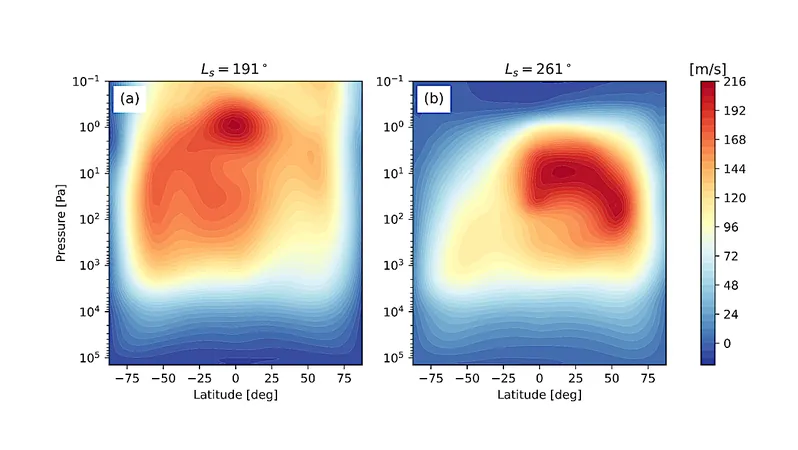
Unraveling the Secrets of Superrotation: How Titan's Stratosphere Defies Expectations
2025-03-21
Author: Rajesh
Introduction
Recent simulations from the advanced TitanWRF global circulation model provide groundbreaking insights into the enigmatic equatorial superrotation of Titan’s stratosphere. This phenomenon, characterized by winds moving faster than the planet's rotation, has baffled researchers for years. But now, we’re closer than ever to understanding the underlying mechanisms that sustain this atmospheric anomaly.
Key Findings
Key findings from the study reveal that wave activity plays a crucial role in the transport of angular momentum—a critical factor in accelerating Titan's equatorial superrotation. Specifically, the research highlights that eddies associated with various wave modes contribute significantly to this process. The most prominent mode identified is zonal wavenumber 1, which acts as a powerful catalyst for prograde acceleration.
Differences Between Models
Interestingly, while both TitanWRF and other models agree on the importance of wave-mean interactions for maintaining superrotation, the specific interactions with zonal flow observed in TitanWRF diverge slightly from those established in previous studies. The TitanWRF model suggests that this interaction occurs primarily during short-term angular momentum transfer events, which span only a few of Titan's solar days (known as sols). These events reflect a repeatable seasonal pattern but do show variability in their timing and intensity each year.
In contrast, the Titan Atmosphere Model (TAM) shows milder angular momentum transfers and predicts that the most significant acceleration of superrotation happens around the solstice in the upper stratosphere. Furthermore, the TAM suggests a more continuous acceleration in the lower stratosphere, which may differ from the intense, albeit episodic, transfer events seen in TitanWRF.
Role of Rossby-Kelvin Instabilities
Another fascinating aspect of the study is the role of Rossby-Kelvin instabilities. These instabilities generate eddies that appear to be a dominant source of prograde angular momentum for Titan's superrotation, similar to findings from the TAM. However, the TitanWRF model proposes that vertically propagating equatorial Kelvin waves may also contribute to this process, showcasing a nuanced and complex atmospheric behavior that continues to surprise scientists.
Conclusion
As we delve deeper into Titan's atmospheric dynamics, we uncover a world that not only enhances our understanding of this distant moon but also enriches our knowledge of planetary atmospheres in general. The intrigue surrounding Titan’s superrotation persists, inviting researchers to explore more about its seasonal patterns, potential weather systems, and climatological phenomena. Could these findings reshape our understanding of not just Titan, but other planetary atmospheres as well? Only time will tell!



 Brasil (PT)
Brasil (PT)
 Canada (EN)
Canada (EN)
 Chile (ES)
Chile (ES)
 Česko (CS)
Česko (CS)
 대한민국 (KO)
대한민국 (KO)
 España (ES)
España (ES)
 France (FR)
France (FR)
 Hong Kong (EN)
Hong Kong (EN)
 Italia (IT)
Italia (IT)
 日本 (JA)
日本 (JA)
 Magyarország (HU)
Magyarország (HU)
 Norge (NO)
Norge (NO)
 Polska (PL)
Polska (PL)
 Schweiz (DE)
Schweiz (DE)
 Singapore (EN)
Singapore (EN)
 Sverige (SV)
Sverige (SV)
 Suomi (FI)
Suomi (FI)
 Türkiye (TR)
Türkiye (TR)
 الإمارات العربية المتحدة (AR)
الإمارات العربية المتحدة (AR)